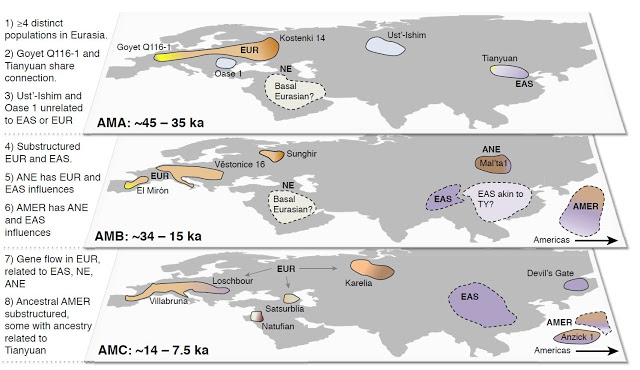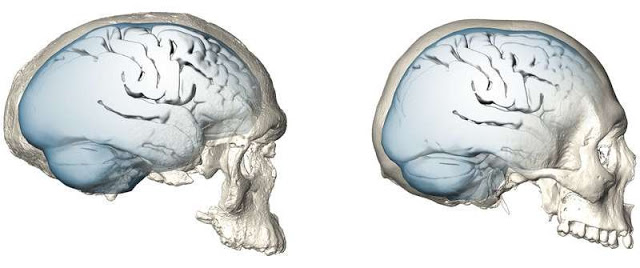William sent in the link, www.yahoo.com/news/ancient-human-genomes-reveal-complicated-183200123.html … but see also https://archaeologynewsnetwork.blogspot.co.uk/2018/01/ancient-eurasian-d… … where the genetics of modern humans appear to contradict fossil evidence of modern humans. It was suggested in the Phil Salmon post at https://judithcurry.com/2018/01/25/ (see yesterday's post) there was a bottleneck coinciding with the Mount Toba super volcano eruption that has been dated around 74,000 years ago. The implication was that modern humans prior to that date have not passed on their genes to those that came afterwards. Only a small fraction of modern humans survived. In the comments Phil Salmon was taken to task and it was established a bottleneck that early was unlikely – but may have occurred later (around 40,000 years ago). In the two links at the top of this page it is said vey little was known about the genetic relationship between modern humans in the Upper Palaeolithic and the modern human population of the world (between 45,000 and 7500 years ago). However, dna sequencing has propelled our knowledge forwards with some unexpected genetic connections between individuals in Europe and Siberia. In a study in Tracks in Genetics scientists at the Chinese Academy of Sciences in Beijing have looked at the genomes of 20 individuals – including one from central Siberia dated 45,000 years ago. They found that between 35,000 and 45,000 years ago four distinct populations were present – early Asian and early Europeans (as well as individuals with an ancestry that has completely disappeared). Is this telling us that a bottleneck more properly should be dated around 40 to 30,000 years ago?
Later, DNA sequencing showed a similarity between Asians and Europeans – suggesting a genetic Asian-European separation likely occurred around 40,000 years ago. By 7500 to 14,000 years ago (at the end of the Ice Age) the population accross Eurasia showed genetic similarities indicating greater interactions between geographically distinct populations (or a shift of people from cental Asia towards Europe after the Ice Age as a result of Siberia becoming colder and Europe becoming milder.
 … The analysis also revealed two Neanderthal mixing events – one approximately 50 to 60,000 years ago, and another around 37,000 years ago. Aftern that date Neadnerthal ancestry gradually diminished (as no more Neanderthals existed to beef up the genes). Genetic studies of ancient individuals show the presence of distince subpopulations in Europe and Asia and these in turn contributed different amounts of ancestry to the more recent subpopulations. The team intend to expand the DNA sequencing to China, Oceania, Africa, and the Americas. Exciting research.
… The analysis also revealed two Neanderthal mixing events – one approximately 50 to 60,000 years ago, and another around 37,000 years ago. Aftern that date Neadnerthal ancestry gradually diminished (as no more Neanderthals existed to beef up the genes). Genetic studies of ancient individuals show the presence of distince subpopulations in Europe and Asia and these in turn contributed different amounts of ancestry to the more recent subpopulations. The team intend to expand the DNA sequencing to China, Oceania, Africa, and the Americas. Exciting research.
Meanwhile, at https://archaeologynewsnetwork.blogspot.co.uk/2018/01/modern-human-brain… … scientists in Germany are researching just when the globular brain shape of modern humans evolved …
 … they found it developed gradually and eventually only reached modern conditions recently. Fossil modern humans go back at least 300,000 years according to recent discovery in Morocco. Analysis of the fossil remains, together with modern human remains from Ethiopia and South Africa, suggest these early modern humans were not fully modern (so to speak). Their faces and teeth look modern but their brain case, or skull, has an archaic look (with similarities to Neanderthals). The globular brain case, on the right, is characteristic of skulls of present day modern humans, as well as more gracile features. It seems the much vaunted fossil modern humans are really not very modern at all.
… they found it developed gradually and eventually only reached modern conditions recently. Fossil modern humans go back at least 300,000 years according to recent discovery in Morocco. Analysis of the fossil remains, together with modern human remains from Ethiopia and South Africa, suggest these early modern humans were not fully modern (so to speak). Their faces and teeth look modern but their brain case, or skull, has an archaic look (with similarities to Neanderthals). The globular brain case, on the right, is characteristic of skulls of present day modern humans, as well as more gracile features. It seems the much vaunted fossil modern humans are really not very modern at all.
The paper is in Science Advances (January 2018) and the researchers used micro computed tomography scans to create virtual imprints of the natural bony brain cases, so called endocasts that approximate brain size and shape. They were able to document a globular shape change withing Homo sapiens from an elongated endocranial shape towards a more globular shapes is in present day humans. This indicates modern brain organisation evolved between 100,000 and 35,000 years ago. Importantly, these shapes evolved independent of brain size. Even the oldest fossil from Morocco fell within present day brain size variability.
